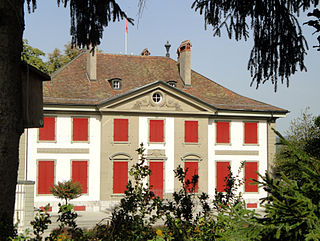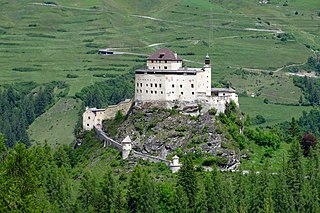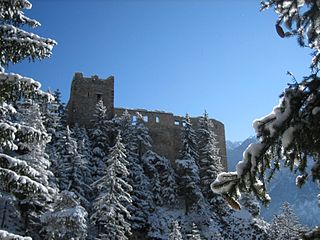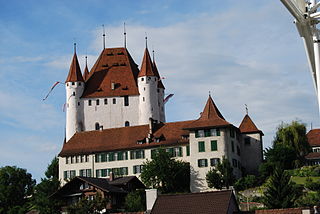| Stein Castle | |
|---|---|
Festung Stein | |
| Baden | |
 | |
| Coordinates | 47°28′23.38″N8°18′19.62″E / 47.4731611°N 8.3054500°E Coordinates: 47°28′23.38″N8°18′19.62″E / 47.4731611°N 8.3054500°E |
| Type | hill castle |
| Code | CH-AG |
| Height | 445 m above the sea |
| Site information | |
| Condition | Ruins (destroyed 1712) |
| Site history | |
| Built | Before 1000, 1658–1670 |
Stein Castle (German : Schloss Stein or Ruine Stein) is a castle ruin above the municipality of Baden in the canton of Aargau in Switzerland. It is a Swiss heritage site of national significance. [1]

German is a West Germanic language that is mainly spoken in Central Europe. It is the most widely spoken and official or co-official language in Germany, Austria, Switzerland, South Tyrol in Italy, the German-speaking Community of Belgium and Liechtenstein. It is one of the three official languages of Luxembourg and a co-official language in the Opole Voivodeship in Poland. The languages that are most similar to the German are the other members of the West Germanic language branch, including Afrikaans, Dutch, English, the Frisian languages, Low German/Low Saxon, Luxembourgish, and Yiddish. There are strong similarities in vocabulary with Danish, Norwegian and Swedish, although those belong to the North Germanic group. German is the second most widely spoken Germanic language, after English.

Municipalities are the lowest level of administrative division in Switzerland. Each municipality is part of one of the Swiss cantons, which form the Swiss Confederation. In most cantons municipalities are also part of districts or other sub-cantonal administrative divisions.

Baden, sometimes unofficially, to distinguish it from other Badens, called Baden bei Zürich or Baden im Aargau, is a municipality in Switzerland. It is the seat of the district of Baden in the canton of Aargau. Located 25 km (16 mi) northwest of Zürich in the Limmat Valley mainly on the western side of the Limmat, its mineral hot springs have been famed since at least the Roman era. Its official language is German, but the main spoken language is the local Alemannic Swiss German dialect. Its population in 2010 was over 18,000.





















